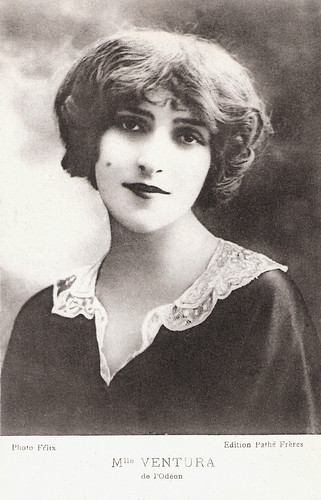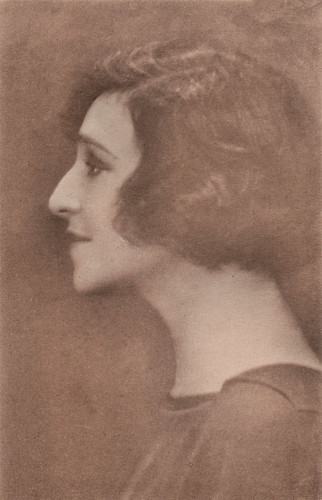Marie or Maria Ventura (1888-1954) was a Romanian-French actress and theatre director. She became well known in the silent cinema with her role in the popular serial Les misérables (1912). From 1919 till 1941, she worked at the Comédie-Française. In 1938, she directed 'Iphigénie' by Racine, becoming the first women to direct a play at the Comédie-Française.

French postcard, no. 12. Photo: Félix.

French postcard by A.N., Paris, no. 50. Photo: G.L. Manuel Frères.
Marie Ventura was born Aristida Maria Ventura in 1888 (IMDb states 1890) in Bucharest, Roumania. She studied at the 'Dramatic Art Conservatory' of Bucharest in 1901.
After her graduation, she moved to France and was a pupil of Mounet-Sully. Then, at the Conservatoire (the Dramatic Art Conservatory of Paris), she studied with Silvain in whose class she won two first prizes in 1905.
The following years, she acted in plays at the Boulevard Theatres and at the Odéon, then led by Antoine. She triumphed in particular in 'Antar' by Chekri Ghanem.
Ventura also appeared in several early silent French films. One of her first was the short Le roman d'un jeune homme riche/The story of a young rich man (Victorin-Hippolyte Jasset, 1909), produced by Éclair.
Other Éclair productions were L'ensorceleuse/The sorcerer (Victorin-Hippolyte Jasset, 1910) and Hérodiade/Herodias (Georges Hatot, Victorin-Hippolyte Jasset, 1910) based on the novel by Gustave Flaubert. In the latter she played Salome, who dazzles King Herod (Karlmos) with her dance, and claims the head of John the Baptist. The production was shot on location in Tunisia, and was an international success.
She moved to Pathé Frères, where she starred as Isabelle de la Croye, a young Burgundian countess in the period drama Quentin Durward (Adrien Caillard, 1912) featuring René Alexandre. She also appeared for Pathé in La fin de Robespierre/The End of Robespierre (Albert Capellani, 1912) with Georges Saillard and Charles de Rochefort, Le fils de Charles Quint/The Son of Charles Quint (Adrien Caillard, 1912) with Léon Bernard and Paul Capellani, and as Nini in Nini l'assommeur/Nini the stunner (N.N., 1912)

French postcard by Edition Pathé Frères. Photo: Félix. Caption: Mlle Ventura de l'Odéon (Miss Ventura of the Odeon).

French postcard by Edition Pathé Frères. Photo: Félix.
Marie Ventura was best known for her role as Fantine Thénardier in the popular Pathé serial Les misérables (Albert Capellani, 1912-1913), based on the novel by Victor Hugo. Henry Krauss starred as Jean Valjean, and Henri Étiévant played his antagonist Javert.
Marie Ventura also starred in an early version of Zaza (Adrien Caillard, 1913), but then the First World War started and probably ended her promising film career.
From 1919 to 1941 Marie Ventura worked at the Comédie-Française. Elegant, with a dramatic temperament and a harmonious voice, she embodied the heroines of Pierre Wolff (Le Voile déchiré/The Torn Veil), Henry Bataille (Maman Colibri/Mom Colibri), Alexandre Dumas fils (La Princesse Georges/The Princess George), Henry Bernstein (Le Secret/The Secret), while playing with great fire the great classical tragedies (Phèdre/Phaedrus, Le Cid/The Cid, Andromaque/Andromache) and romantic dramas (Hernani).
She also interpreted the Repertory, from Molière to Alfred Musset, and created the most contemporary pieces. In 1938, she directed 'Iphigénie' by Jean Racine, becoming the first women to direct a play at the Comédie-Française. She made frequent trips to Roumania and helped to create cultural links between France and her native country.
In the autumn of 1940, after the Nazis had invaded France, Marie Ventura was questioned personally by Jacques Copeau, the Provisionary Administrator of the Comédie-Française, about her origins. She managed to convince Copeau who decided she could remain to work on 'L'Impromptu de Versailles' (The Impromptu of Versailles) by Molière.
But in December 1941, under German pressure, the actress had to retire. After the Liberation, she was reintegrated at the Comédie Française. She then founded a drama class and played on the Boulevards, including in Jean Anouilh's plays 'Colombe' (1950) and 'La Valse des toréadors' (The Waltz of the Toreadors, 1951).
In 1951, she returned for once to the screen in Gibier de potence/Gigolo (Roger Richebé, 1951), starring Arletty and Georges Marchal.
Marie Ventura died in 1954 in Paris. She was 66.

French postcard by Editions Sid, no. 8046. Photo: G.L. Manuel Frères, Paris. The costume on the card refers to a stage play set in the Middle Ages or the Renaissance, but it is unclear which one.

French postcard by Editions Sid, no. 8041. Photo: G.L. Manuel Frères, Paris.
Sources: Comédie Française (French), Wikipedia (French) and IMDb.

French postcard, no. 12. Photo: Félix.

French postcard by A.N., Paris, no. 50. Photo: G.L. Manuel Frères.
A dazzling Salome
Marie Ventura was born Aristida Maria Ventura in 1888 (IMDb states 1890) in Bucharest, Roumania. She studied at the 'Dramatic Art Conservatory' of Bucharest in 1901.
After her graduation, she moved to France and was a pupil of Mounet-Sully. Then, at the Conservatoire (the Dramatic Art Conservatory of Paris), she studied with Silvain in whose class she won two first prizes in 1905.
The following years, she acted in plays at the Boulevard Theatres and at the Odéon, then led by Antoine. She triumphed in particular in 'Antar' by Chekri Ghanem.
Ventura also appeared in several early silent French films. One of her first was the short Le roman d'un jeune homme riche/The story of a young rich man (Victorin-Hippolyte Jasset, 1909), produced by Éclair.
Other Éclair productions were L'ensorceleuse/The sorcerer (Victorin-Hippolyte Jasset, 1910) and Hérodiade/Herodias (Georges Hatot, Victorin-Hippolyte Jasset, 1910) based on the novel by Gustave Flaubert. In the latter she played Salome, who dazzles King Herod (Karlmos) with her dance, and claims the head of John the Baptist. The production was shot on location in Tunisia, and was an international success.
She moved to Pathé Frères, where she starred as Isabelle de la Croye, a young Burgundian countess in the period drama Quentin Durward (Adrien Caillard, 1912) featuring René Alexandre. She also appeared for Pathé in La fin de Robespierre/The End of Robespierre (Albert Capellani, 1912) with Georges Saillard and Charles de Rochefort, Le fils de Charles Quint/The Son of Charles Quint (Adrien Caillard, 1912) with Léon Bernard and Paul Capellani, and as Nini in Nini l'assommeur/Nini the stunner (N.N., 1912)

French postcard by Edition Pathé Frères. Photo: Félix. Caption: Mlle Ventura de l'Odéon (Miss Ventura of the Odeon).

French postcard by Edition Pathé Frères. Photo: Félix.
Elegant, with a dramatic temperament and a harmonious voice
Marie Ventura was best known for her role as Fantine Thénardier in the popular Pathé serial Les misérables (Albert Capellani, 1912-1913), based on the novel by Victor Hugo. Henry Krauss starred as Jean Valjean, and Henri Étiévant played his antagonist Javert.
Marie Ventura also starred in an early version of Zaza (Adrien Caillard, 1913), but then the First World War started and probably ended her promising film career.
From 1919 to 1941 Marie Ventura worked at the Comédie-Française. Elegant, with a dramatic temperament and a harmonious voice, she embodied the heroines of Pierre Wolff (Le Voile déchiré/The Torn Veil), Henry Bataille (Maman Colibri/Mom Colibri), Alexandre Dumas fils (La Princesse Georges/The Princess George), Henry Bernstein (Le Secret/The Secret), while playing with great fire the great classical tragedies (Phèdre/Phaedrus, Le Cid/The Cid, Andromaque/Andromache) and romantic dramas (Hernani).
She also interpreted the Repertory, from Molière to Alfred Musset, and created the most contemporary pieces. In 1938, she directed 'Iphigénie' by Jean Racine, becoming the first women to direct a play at the Comédie-Française. She made frequent trips to Roumania and helped to create cultural links between France and her native country.
In the autumn of 1940, after the Nazis had invaded France, Marie Ventura was questioned personally by Jacques Copeau, the Provisionary Administrator of the Comédie-Française, about her origins. She managed to convince Copeau who decided she could remain to work on 'L'Impromptu de Versailles' (The Impromptu of Versailles) by Molière.
But in December 1941, under German pressure, the actress had to retire. After the Liberation, she was reintegrated at the Comédie Française. She then founded a drama class and played on the Boulevards, including in Jean Anouilh's plays 'Colombe' (1950) and 'La Valse des toréadors' (The Waltz of the Toreadors, 1951).
In 1951, she returned for once to the screen in Gibier de potence/Gigolo (Roger Richebé, 1951), starring Arletty and Georges Marchal.
Marie Ventura died in 1954 in Paris. She was 66.

French postcard by Editions Sid, no. 8046. Photo: G.L. Manuel Frères, Paris. The costume on the card refers to a stage play set in the Middle Ages or the Renaissance, but it is unclear which one.

French postcard by Editions Sid, no. 8041. Photo: G.L. Manuel Frères, Paris.
Sources: Comédie Française (French), Wikipedia (French) and IMDb.
No comments:
Post a Comment